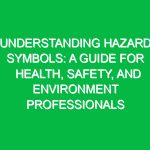Introduction to Hazard Symbols
Hazard symbols are graphical representations designed to convey crucial safety information about hazardous materials and situations. These symbols act as a visual shorthand, alerting workers, consumers, and the general public to potential dangers associated with specific substances or activities. In the realm of Health, Safety, and Environment (HSE), understanding these symbols is paramount. They not only assist in risk assessment but also play a critical role in fostering a culture of safety within organizations.
For instance, imagine a construction site bustling with activity. Workers are operating heavy machinery, handling chemicals, and navigating around scaffolding. In such an environment, a clear understanding of hazard symbols can mean the difference between safety and disaster. A simple skull and crossbones can alert a worker to the presence of toxic substances, while a flame can indicate flammable materials. In this article, we will decode these symbols, explore associated hazards, and discuss best practices for HSE professionals to enhance workplace safety.
The Importance of Hazard Symbols in HSE
Understanding hazard symbols is not merely academic; it has real-world implications. According to the National Institute for Occupational Safety and Health (NIOSH), an estimated 4,800 workplace fatalities occur annually in the United States alone. Many of these incidents could potentially be avoided if workers were adequately informed about the risks they faced. Hazard symbols serve as an essential part of safety communication, especially in environments where language barriers may exist.
An example from the chemical industry illustrates this point vividly. At a facility handling various hazardous materials, workers from diverse linguistic backgrounds were often confused about the safety protocols. By employing universally recognized hazard symbols, the facility significantly reduced the incidence of unsafe practices, showcasing how effective communication can lead to safer workplaces.
Common Hazard Symbols and Their Associated Risks
To decode hazard symbols effectively, it’s vital to familiarize oneself with the most common types and the risks they represent. Here are several prominent hazard symbols:
1. Toxic (Skull and Crossbones)
This symbol signifies substances that can cause serious health issues or death upon exposure, even in small amounts. Common examples include pesticides and certain industrial chemicals. The associated risks include respiratory problems, skin irritation, or long-term health effects such as cancer.
2. Flammable (Flame)
Indicating materials that can easily ignite, this symbol is prevalent in the handling of solvents, fuels, and other combustible materials. The risks here include explosions and fire hazards, which can lead to severe injuries or property damage.
3. Corrosive (Test Tube and Hand)
This symbol warns of substances that can cause destruction to living tissue or severe corrosion of materials. Commonly found in acids and alkalis, the associated risks include chemical burns and damage to equipment.
4. Environmental Hazard (Tree and Fish)
This symbol indicates substances that pose threats to the environment, such as aquatic toxicity or long-term ecological damage. The risks include contamination of water sources, soil degradation, and harm to wildlife.
5. Explosive (Explosive Symbol)
Used for materials that may explode under specific conditions, such as heat or pressure, this symbol is commonly seen in the handling of explosives or certain chemicals. Risks include catastrophic explosions, injuries, and fatalities.
Identifying Additional Hazards
Beyond the common symbols discussed, HSE professionals must remain vigilant for other potential hazards. For example, the biohazard symbol warns of biological substances that pose a risk to human health. This can include anything from medical waste to certain pathogens. Understanding the breadth of hazard symbols ensures a comprehensive approach to risk management.
Consider a personal anecdote from a laboratory safety officer. During a routine inspection, the officer noticed that several hazardous materials were not properly labeled with their corresponding symbols. This oversight could have led to significant risks, including accidental exposure and chemical spills. The experience underscored the importance of consistent labeling and the clear communication of hazards through symbols.
Safety Precautions and Best Practices
Once the hazards associated with various symbols are understood, the next step is implementing safety precautions. Here are some best practices for HSE professionals:
1. Training and Education
Regular training sessions should be conducted to educate employees about hazard symbols, their meanings, and the associated risks. This can take the form of workshops, e-learning modules, or hands-on demonstrations.
2. Clear Signage
Ensure that all hazardous areas are clearly marked with appropriate hazard symbols. Signage should be visible and placed at key locations to serve as constant reminders of the potential dangers.
3. Personal Protective Equipment (PPE)
Encourage the use of appropriate PPE when working with hazardous materials. This includes gloves, goggles, respirators, and protective clothing, depending on the type of hazard present.
4. Regular Inspections
Conduct regular inspections of the workplace to ensure compliance with safety standards. This includes checking that hazard symbols are correctly displayed and that materials are stored appropriately.
5. Emergency Preparedness
Have clear emergency procedures in place for incidents involving hazardous materials. This should include evacuation routes, emergency contact numbers, and first-aid procedures.
Regulations and Standards Governing Hazard Symbols
In many regions, specific regulations govern the use of hazard symbols. For instance, in the United States, the Occupational Safety and Health Administration (OSHA) mandates proper labeling of hazardous materials under the Hazard Communication Standard (HCS). This standard requires that all hazardous materials be labeled with appropriate symbols and that Material Safety Data Sheets (MSDS) be readily available.
Globally, the Globally Harmonized System of Classification and Labelling of Chemicals (GHS) provides a standardized approach to hazard communication. It aims to ensure that information on chemical hazards is consistent across borders, improving safety in international trade.
In Europe, the Classification, Labelling and Packaging (CLP) regulation aligns with the GHS to ensure that hazardous substances are classified and labeled in a coherent manner.
Conclusion
Decoding hazard symbols is a critical skill for HSE professionals. These symbols serve as essential tools for communicating risks and promoting safety in various environments. By understanding the meanings of these symbols and implementing effective safety practices, HSE professionals can significantly reduce the likelihood of accidents and injuries.
As we navigate through an ever-evolving landscape of workplace hazards, the importance of clear communication cannot be overstated. Whether it’s through proper training, consistent signage, or adherence to regulations, the goal remains the same: to protect lives and ensure a safer working environment for all. Remember, safety is not just a policy—it’s a culture that begins with awareness and education.


